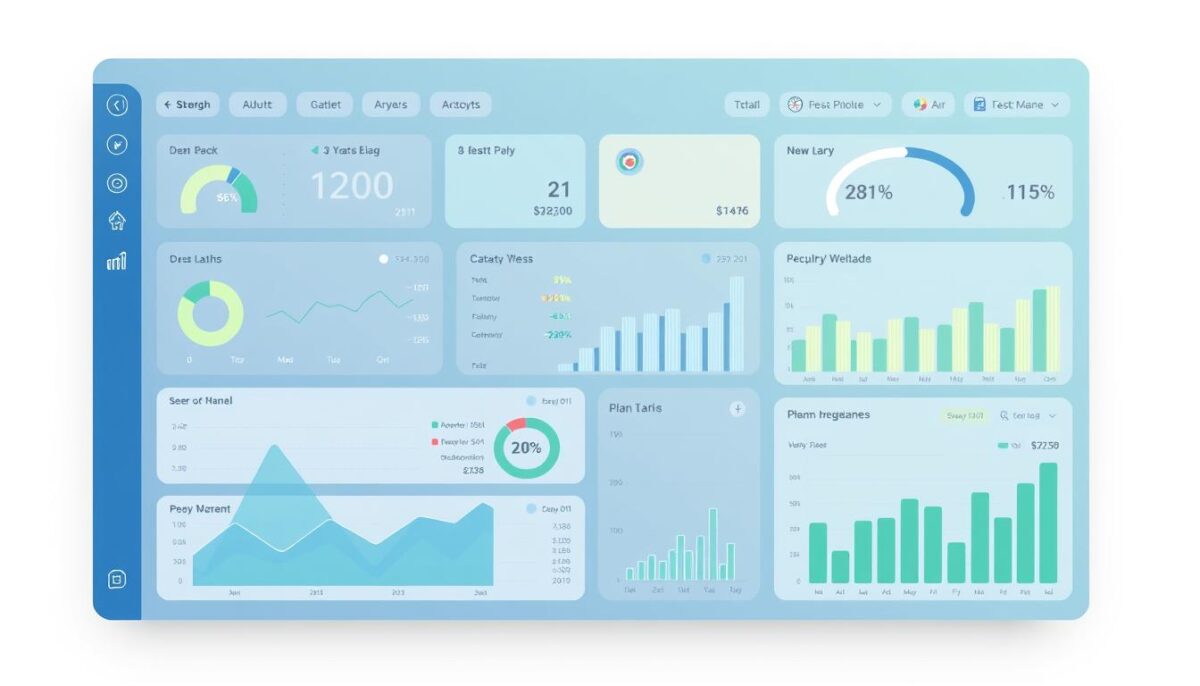In today’s fast-paced business world, managing money well is key to success. Sage Budgeting and Planning offers a top-notch solution for handling your company’s finances. But, what sets Sage apart from others? Let’s dive into how this innovative tool can change the game for your financial goals.
Key Takeaways
- Sage Budgeting and Planning provides a robust set of tools for financial forecasting and strategic planning.
- The platform offers real-time data updates, reducing the risk of human error and ensuring the accuracy of your financial information.
- Sage Budgeting and Planning simplifies the process of creating and managing budgets, allowing you to stay on top of your financial performance.
- Integrating Sage with other financial tools can further streamline your operations and provide a comprehensive view of your company’s finances.
- Collaboration features in Sage enable seamless teamwork, ensuring everyone is on the same page when it comes to budgeting and planning.
Understanding Sage Budgeting and Planning
Sage Budgeting and Planning is a top-notch financial management tool. It helps with cost management, resource allocation, and business intelligence. It’s designed for all kinds of organizations.
At its heart, Sage Budgeting is an automated tool. It makes budgeting easier. This lets businesses control their finances better and make smarter choices.
What Is Sage Budgeting?
Sage Budgeting is a software that makes budgeting simple. It lets businesses manage and track their budgets easily. It’s a central place for income, expenses, and financial forecasts.
This way, users can see their financial health in real-time. It’s all about understanding your finances better.
Key Features of Sage Budgeting
- Automated budgeting tools to streamline the planning process
- Scenario planning capabilities to test different budget assumptions
- Robust reporting and analytics for in-depth financial analysis
- Customizable dashboards and data visualizations for improved visibility
- Seamless integration with other Sage financial and ERP solutions
Benefits of Using Sage for Financial Management
Using Sage Budgeting brings many benefits. It improves financial management in several ways. Here are some:
- Improved cost management: Sage’s tools give a clear view of spending. This helps find ways to save money.
- Enhanced resource allocation: Sage helps align financial resources with goals. This ensures resources are used well.
- Stronger business intelligence: Its reporting and analytics help make data-driven decisions. This empowers leaders to make better financial choices.
In summary, Sage Budgeting and Planning is a great tool. It helps businesses of all sizes manage their finances better. It optimizes resource use and provides valuable insights for growth.
How Sage Budgeting Enhances Financial Accuracy
Accurate financial planning and analysis are key for any business. They help make informed decisions and achieve long-term success. Sage Budgeting and Planning offers powerful features that improve your financial data accuracy. This ensures you have a clear and reliable picture of your company’s financial health.
Reduced Human Error
Budgeting and forecasting can be complex and time-consuming. They often lead to human errors. Sage Budgeting and Planning automates these processes, reducing the risk of mistakes. Its advanced data analysis capabilities help identify and correct any discrepancies. This creates a robust and trustworthy financial foundation.
Real-Time Data Updates
In today’s fast-changing business environment, outdated financial information can lead to poor decisions. Sage Budgeting and Planning integrates with your accounting systems. It provides real-time data updates to ensure your financial modeling and forecasting are current. This allows you to make timely, informed decisions that align with your company’s evolving needs.
“Sage Budgeting and Planning has been a game-changer for our finance team. The accuracy and timeliness of the data have helped us make more informed decisions and better manage our financial resources.”

Getting Started with Sage Budgeting and Planning
Starting your financial journey with Sage can feel overwhelming. But, with the right steps, you’ll soon manage your finances better. You’ll also improve your ability to forecast your finances. Let’s look at how to set up your Sage account and make it work best for you.
Setting Up Your Account
To begin, just go to the Sage website and sign up. The sign-up process is easy and will ask for your business details. This includes your industry, business size, and financial goals. Sage will then customize the platform for you.
Importing Financial Data
Importing your financial data is a key step in setting up your Sage account. Sage easily connects with many accounting and financial software. This makes moving your data quick and easy. By bringing in your past financial records, you’ll have a strong base for your sage budgeting and planning efforts. You’ll also get insights into your past financial performance.
Initial Configuration Tips
- Customize your dashboard to show the most important financial metrics and KPIs for your business.
- Set up budget categories and subcategories that match your business’s financial setup.
- Use alert thresholds to get notified when your spending or revenue changes from your forecasted financial forecasting.
- Learn about Sage’s reporting and analysis tools to understand your financial data better.
By following these steps, you’ll unlock Sage’s full potential. This will help you manage your finances better and make informed decisions.
Navigating the Sage Budgeting Interface
Learning to use the Sage Budgeting interface is key to getting the most out of this financial tool. It’s made to be easy and straightforward, letting you find important financial info quickly.
Dashboard Overview
The dashboard is at the center of the Sage Budgeting interface. It’s your main spot for all financial data and insights. Here, you can see your company’s financial health at a glance, including budget tracking, expense reports, and revenue forecasts.
With just a few clicks, you can dive deeper into your business. This lets you find valuable data to help make better decisions.
Customizing Your Views
The Sage Budgeting interface is great because you can make it your own. You can change the dashboard and reports to show what’s most important to you. This makes managing your finances easier and ensures you’re always working with the latest, most relevant data.
- Rearrange and resize dashboard widgets to prioritize the most critical financial metrics
- Create custom reports that provide insights into specific areas of your business, such as sales performance or inventory management
- Set up alerts and notifications to stay informed about budget deviations, cash flow changes, and other important financial events
By getting good at using the Sage Budgeting interface, you can unlock its full power. This means better financial decisions and success for your business in the long run.

Creating Effective Budgets in Sage
Making a good budget is key for any business to do well. Sage Budgeting and Planning has tools to help manage costs and resources. Here are some tips for making a budget in Sage.
Best Practices for Budget Creation
To make a budget that works, follow these steps:
- Make sure your budget matches your business goals.
- Get input from important people in your company.
- Use Sage’s forecasting to predict income and expenses.
- Have a clear plan for making and approving budgets.
Setting Budget Limits
Keeping costs under control is vital for financial health. Sage lets you set limits for different expenses, like:
- Operational Costs: Watch and control daily expenses like labor and supplies.
- Capital Expenditures: Plan for big investments like new equipment.
- Marketing and Sales: Manage spending on marketing and sales efforts.
Tracking Budget Performance
It’s important to keep an eye on your budget. Sage gives you real-time data and reports to:
- See how you’re doing against your budget.
- Find out why you’re off track.
- Change your budget to stay on track.
Using Sage’s budgeting tools helps manage cost management and resource allocation. This sets your business up for financial success.
| Budget Category | Budgeted Amount | Actual Expenditure | Variance |
|---|---|---|---|
| Operational Costs | $500,000 | $480,000 | $20,000 |
| Capital Expenditures | $250,000 | $275,000 | ($25,000) |
| Marketing and Sales | $150,000 | $165,000 | ($15,000) |
Integrating Sage with Other Financial Tools
Sage Budgeting and Planning is a top-notch financial management tool. It really comes alive when paired with other tools. This combo lets businesses dive deeper into financial modeling and cash flow projections.
Popular Tools to Consider
- Microsoft Excel: Sync your Sage data with Excel for detailed financial analysis and reports.
- QuickBooks: Link Sage with QuickBooks to make accounting smoother and get a full financial view.
- Google Sheets: Work on budgets and forecasts together with Sage and Google Sheets.
- Tableau: Use Sage data in Tableau for interactive dashboards and insights.
Step-by-Step Integration Guide
Connecting Sage with other tools is easy and customizable. Here’s a basic guide to start:
- Pick the financial tools you need based on your business and software setup.
- Check the integration guides from Sage and the tool you chose to understand the setup.
- Make sure you have the right permissions to link the systems.
- Follow the integration steps to connect Sage with the tool.
- Test the link to make sure data moves correctly and the system works well.
- Customize and automate the integration for better performance and features.
By linking Sage with other financial tools, businesses can make the most of their data. This leads to better financial planning and decision-making.
Collaboration Features in Sage Budgeting
Effective financial management needs teamwork, and Sage Budgeting makes it easy. It helps teams work together on planning and risk assessment. With Sage’s tools, teams can make budgeting smoother and stay focused on financial goals.
Sharing Budgets with Team Members
Sage Budgeting lets you share budgets with your team. You can give them the right access and permissions. This way, everyone works with the latest financial data, keeping things clear and honest.
Utilizing Comments and Notes
The commenting and note-taking in Sage Budgeting add value. Team members can share their thoughts and feedback on budget items. This keeps a detailed record and boosts planning efforts.
These features help teams collaborate, spot risks, and make smart choices. Sage Budgeting makes strategic planning and risk assessment better. It leads to better financial management for businesses.
Reporting and Analytics in Sage Budgeting
Sage Budgeting has powerful tools for reporting and analytics. These tools help businesses make smart, data-based choices. You can get detailed financial reports and spot important trends. This info is key for better financial management.
Generating Reports
Sage Budgeting lets you make many types of reports. You can get income statements, balance sheets, and cash flow analyses. The platform is flexible, so you can tailor reports to fit your needs.
These reports are easy to access, share, and export. This makes it simple to fit them into your current work flow.
Analyzing Financial Trends
The tools in Sage Budgeting help you track financial trends. You can watch your revenue, expenses, and profit over time. This gives you insights into how your business is doing.
With this info, you can make better decisions. You can find ways to improve, use resources better, and grow your business.
Making Informed Decisions
Sage Budgeting’s reports and analysis tools help you make smart choices. You’ll know your financial situation well. This lets you handle challenges, grab opportunities, and plan for the future.
This level of business intelligence and data analysis is crucial in today’s market. It can really change the game for your business.
| Report Type | Key Metrics Included |
|---|---|
| Income Statement | Revenue, Cost of Goods Sold, Gross Profit, Operating Expenses, Net Income |
| Balance Sheet | Assets, Liabilities, Equity |
| Cash Flow Statement | Cash from Operating Activities, Cash from Investing Activities, Cash from Financing Activities, Net Change in Cash |

“The reporting and analytics capabilities in Sage Budgeting have been a game-changer for our business. We can now make informed, data-driven decisions that have significantly improved our financial performance.”
Common Challenges with Sage Budgeting
Sage Budgeting and Planning is a powerful tool for managing finances. Yet, users might run into some common problems. Knowing these issues and how to fix them can make budgeting smoother and more effective.
Addressing Technical Issues
Technical problems are a big worry for many users. Issues like data integration problems, system crashes, or trouble using the software are common. Here’s how to tackle these issues:
- Always check for updates and install them right away. This keeps your software current with the latest fixes and features.
- Make sure your computer meets Sage’s system requirements. This ensures everything runs smoothly.
- If you hit a snag, don’t hesitate to contact Sage’s customer support. They can help you troubleshoot.
Avoiding Budgeting Pitfalls
Even with Sage’s help, budgeting can still be tricky. To steer clear of common mistakes, follow these tips:
- Keep your budget up to date. Changes in the market or your business can affect your numbers.
- Use Sage’s tools for risk assessment and financial forecasting. They help you spot and plan for potential problems.
- Work with different teams to get everyone’s input. This makes your budget more complete and accurate.
By fixing technical problems and using smart budgeting strategies, you can get the most out of Sage Budgeting and Planning. This keeps your financial management strong and reliable.
| Technical Issue | Recommendation |
|---|---|
| Data integration problems | Ensure compatible data sources and follow Sage’s integration guidelines |
| Software glitches | Keep Sage Budgeting and Planning up-to-date with the latest version |
| Difficulty navigating the interface | Utilize Sage’s training resources and customer support for guidance |
Sage Budgeting Training and Resources
Starting your journey with Sage budgeting and planning is exciting. It’s important to keep up with new tools and best practices. Sage offers many training resources to help you use the platform’s features well.
Official Sage Learning Center
The Sage Learning Center is a great online place for Sage users. It has webinars, tutorials, and guides. It’s perfect for learning Sage budgeting and planning, no matter your skill level.
Recommended Online Courses
- Udemy’s “Sage Budgeting and Planning for Beginners”
- Coursera’s “Mastering Sage Budgeting and Financial Reporting”
- LinkedIn Learning’s “Sage Budgeting: Tips and Techniques”
These courses offer a structured way to learn. They cover from the basics to advanced features. Learning more about Sage budgeting and planning helps you make better financial choices for your business.
| Course | Provider | Duration | Level |
|---|---|---|---|
| Sage Budgeting and Planning for Beginners | Udemy | 3 hours | Beginner |
| Mastering Sage Budgeting and Financial Reporting | Coursera | 6 weeks | Intermediate |
| Sage Budgeting: Tips and Techniques | LinkedIn Learning | 1 hour | Advanced |
Using these training resources will help you become a Sage expert. You’ll have the skills to make smart financial decisions for your business.
Conclusion: Why Choose Sage Budgeting for Your Business?
Sage Budgeting is a top choice for managing your business’s finances. It offers a complete solution for long-term financial planning. With Sage’s advanced tools, you can see your company’s financial future clearly. This helps you make smart decisions that boost growth and profits.
Long-Term Financial Planning Benefits
Sage Budgeting’s features, like real-time updates and less room for mistakes, help you make accurate forecasts. This lets you see what’s coming and plan for the future. You can spot challenges and opportunities, and make plans for your business’s long-term success.
Summary of Key Features
Sage Budgeting has many useful features. It makes budgeting easy and integrates well with other financial tools. It also helps you work together on budgets and gives detailed reports. With Sage, you can make your financial management smoother, improve cash flow, and set your business up for success.
FAQ
What is Sage Budgeting and Planning?
Sage Budgeting and Planning is a financial management solution for businesses. It streamlines budgeting, forecasting, and strategic planning. It offers tools to improve financial accuracy and manage costs.
What are the key features of Sage Budgeting?
Sage Budgeting has automated budgeting tools and scenario planning. It also updates data in real-time and offers business intelligence. Advanced financial modeling is another key feature.
How does Sage Budgeting enhance financial accuracy?
Sage Budgeting reduces human error and updates data in real-time. It also improves financial modeling. This ensures your budgeting is accurate and up-to-date.
How do I get started with Sage Budgeting and Planning?
To start, set up your account and import your financial data. Configure the platform for your business needs. Our team can guide you through the setup.
How do I navigate the Sage Budgeting interface?
The Sage Budgeting interface has a comprehensive dashboard. You can customize it to fit your business needs. This makes it easier to access and analyze important data.
What are the best practices for creating effective budgets in Sage?
Set realistic budget limits and track performance. Use cost management and resource allocation tools. These practices help manage budgets effectively.
How can I integrate Sage Budgeting with other financial tools?
Sage Budgeting integrates with tools like QuickBooks and Excel. Our guide helps you connect Sage with your tools. This enhances financial modeling and cash flow projections.
How can I collaborate with my team using Sage Budgeting?
Sage Budgeting has features for team collaboration. You can share budgets and use comments for communication. This supports strategic planning and risk assessment across departments.
What reporting and analytics capabilities does Sage Budgeting provide?
Sage Budgeting offers detailed financial reports and trend analysis. These tools help make informed decisions. They provide insights into financial performance and optimize budgeting processes.
What are some common challenges with Sage Budgeting, and how can they be addressed?
Common challenges include technical issues and budgeting pitfalls. Our team can help troubleshoot and improve risk assessment and forecasting. We offer guidance to overcome these challenges.
What training and resources are available for Sage Budgeting?
Sage provides training resources for the Budgeting and Planning platform. This includes the Sage Learning Center and online courses. Ongoing education is key to maximizing Sage’s capabilities.







